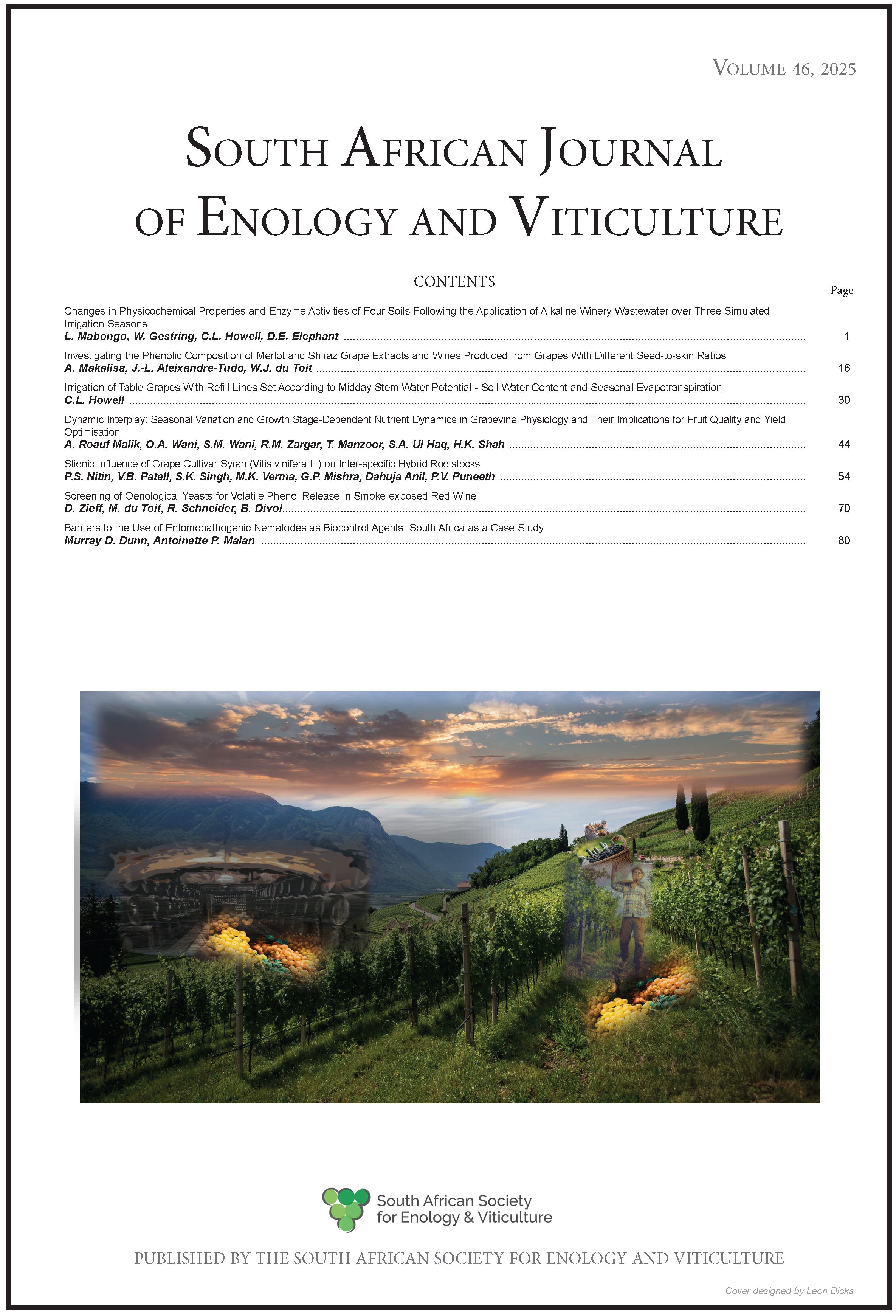Changes in Physicochemical Properties and Enzyme Activities of Four Soils Following the Application of Alkaline Winery Wastewater over Three Simulated Irrigation Seasons
DOI:
https://doi.org/10.21548/46-6624Abstract
The in-field fractional use (augmentation) of undiluted alkaline winery wastewater (WW) with raw water for the irrigation of grapevines can reduce the abstraction of water from natural resources and mitigate global water shortages. However, undiluted WW could pose a threat to soil function and enzyme activities, which are early soil quality indicators. Hence, this study used a pot experiment to compare changes in physicochemical properties and enzyme activities of four different soils irrigated with undiluted WW and municipal water (MW) over three simulated irrigation seasons. The soils were collected from the top 0 cm to 30 cm soil layer to which no WW had previously been applied – in the Stellenbosch (sandy loam and sand), Robertson (clay loam) and Lutzville (sand) regions. The water sources were MW, which served as the control, and undiluted WW, and they were both analysed before each irrigation event. Irrigation with undiluted WW resulted in larger increases in soil pH, electrical conductivity (EC) and exchangeable K and Na for all soils and simulated irrigation seasons. The activities of acid phosphatase, β-glucosidase and urease were negatively affected by the addition of undiluted WW. Changes in acid phosphatase activity were negatively correlated with changes in soil pH and EC, while changes in β-glucosidase activity were negatively correlated with changes in soil pH, EC and exchangeable K, Na and Mg. The pH had a dominant effect because of its influence on enzyme activities, precipitation reactions and the development of salinesodic soils. Root exudates, acidification from nitrogen fertiliser and the uptake of K by crops can mitigate the potential risk of using undiluted alkaline wastewater.
Downloads
Downloads
Published
Issue
Section
License
A copyright form will be e-mailed to the corresponding author when the manuscript has been accepted for publication.
In principle, the Author agrees to the following when he/she signes the copyright agreement:
I hereby assign to the SOUTH AFRICAN SOCIETY FOR ENOLOGY AND VITICULTURE (SASEV) the copyright of the text, tables, figures, supplementary material, illustrations and other information (the Material) submitted with the manuscript to be published in SOUTH AFRICAN JOURNAL OF ENOLOGY AND VITICULTURE (SAJEV) (the "Article"). The copyright becomes effective from the date the Article has been accepted for publication in SAJEV.
This is an open access journal, and the authors and journal should be properly acknowledged, when works are cited.
Author's may use the publishers version for teaching purposes, in books, theses, dissertations, conferences and conference papers.
A copy of the authors' publishers version may also be hosted on the following websites:
- Non-commercial personal webpage or blog.
- Institutional webpage.
- Authors Institutional Repository.
The following notice should accompany such a posting on the website: This is an electronic version of an article published in SAJEV, Volume XXX, number XXX, pages XXX - XXX, DOI. Authors should also supply a hyperlink to the original paper or indicate where the original paper (www.journals.ac.za/index.php/sajev/) may be found.
Authors publishers version, affiliated with the Stellenbosch University will be automatically deposited in the University's Institutional Repository SUNScholar.
Articles as a whole, may not be re-published with another journal.
The following license applies:
Attribution CC BY-NC-ND 4.0

